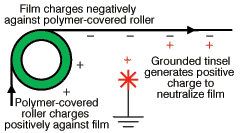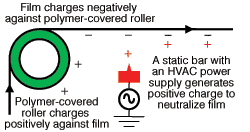Static Beat: Choosing Passive or Active Ionizers
- Published: July 01, 2010, By By Dr. Kelly Robinson Contributing Editor
Static charges can be an annoyance that requires some attention, and sometimes static can be a serious threat to your operation. To solve a static problem, many good static neutralizers are available. How do you choose which ones to use?

Static neutralizers come in two broad categories: passive and active. Passive neutralizers, such as conductive brushes, tinsel, static dissipative fabrics, and ionizing strings and rods, require no external power. To operate, the neutralizer simply needs to be connected to electrical ground as shown in Figure 1.
The electric field from the charged film extends to the grounded tinsel. Sharp edges on the tinsel intensify the electric field causing a low energy corona discharge, which generates both positive and negative ions. In this case, the positive corona ions are drawn by the electric field back to the film, where they neutralize the negative static. While passive neutralizers require no external power, the electric field from the film must be high enough to generate corona ions. When the film static is too low, passive ionizers don't work. For this reason, passive ionizers cannot get rid of all of the film static. The electric field after a passive ionizer is typically in the range 1-2 kV/cm.
Active neutralizers, such as static bars and ionizing blowers, are energized by a high voltage AC (HVAC) power supply as shown in Figure 2. The power supply provides AC voltage that is typically in the range of 4-7 kV. This high voltage generates both positive and negative corona ions at the sharp points on the pins. The electric field from the film draws ions of the correct polarity to neutralize the static. Active ionizers can neutralize the film static completely because the corona ions are available even when the film has no static charge. The electric field after an active neutralizer is typically in the range 0-0.1 kV/cm.

To select an appropriate static neutralizer, you must answer the key question: “How much static is tolerable?” If an electric field of 2 kV/cm causes no problems for your product, then select an inexpensive passive ionizer. If your application is more demanding and the electric field must be kept below 0.5 kV/cm to avoid problems, you must invest in an active ionizer.
To determine how much static is tolerable, use your electrostatic fieldmeter to take some measurements. I have used two different measurement strategies: make a control chart or complete a static survey. Both strategies are effective, so you can use the one that is best suited to your operation.
When your process is operating normally, make a control chart of your static measurements to reveal the normal and tolerable level of static. You'll see when static exceeds these normal levels, indicating that you need to take corrective action. The procedure for making a control chart may be well known in your workplace. If not, there are many good resources available. On my book shelf is Guide to Quality Control by Kaoru Ishikawa (ISBN: 92-833-1036-5). To collect the data for a control chart, select a few key locations, and use your fieldmeter to measure the electric field near the film. Document the locations so you can make the measurements the same way every time. With so many adult websites out there, it can be hard to figure out which one will give you the best deal on the type of adult sites you are looking for. The best websites will offer some type of "live sex cam" on their website and provide you with a link to the adult video chat room that they have set up for you. This is a service that adult websites have been offering to the adult community for years, but you must sign up with a live sex cam website if you want to take advantage of the opportunity. That means you have to join in order to have access to the adult video chat room.
Completing a static survey normally is scheduled to qualify a process for operation after a shutdown for maintenance or for an equipment upgrade. Measure the levels of static from the unwinding roll through the entire process ending with the winding roll. Carefully document the locations for each measurement so you can obtain consistent data. Your readings will reveal the levels of static throughout your process.
Select the appropriate static neutralizer by knowing what level of static is tolerable in your process. I invite you to ask questions about this column and to suggest a topic for a future “Static Beat.”
Static control expert Dr. Kelly Robinson, president of Electrostatic Answers, has 27+ years of experience in problem-solving and consulting. Contact him at 585-425-8158; kelly.robinson@electrostaticanswers.com; www.electrostaticanswers.com.












